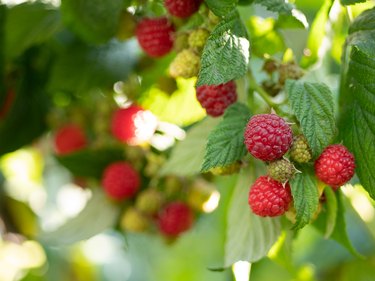
The leaves of a healthy, thriving raspberry plant (Rubus idaeus) are invariably dark green. At times, however, you may notice that the leaves are turning yellow due to a condition called chlorosis. This condition is caused by a lack of chlorophyll, which is the pigment that gives leaves their green color. In some cases, raspberry leaves turning yellow might be a normal part of the plant's progression. However, chlorosis can also be a sign that the plant needs fertilizer or has become diseased.
Raspberry Leaves Turning Yellow
Video of the Day
While raspberry plants have perennial root systems, the stems are biennial, which means that they live for only two years. It is completely normal for the leaves of second-year stems, known as floricanes, to turn yellow and drop in late summer after they yield fruit. On the other hand, yellowing leaves on primocanes, which is the term for first-year canes, is more problematic.
Video of the Day
Raspberry leaves turning yellow might be an indication that the plant is lacking vital nutrients, especially if the veins remain green. Like most other plants, raspberries require nitrogen, phosphorus and potassium in order to thrive. Yellow raspberry leaves can be a sign of a nitrogen deficiency. Not enough iron or manganese, two trace elements that raspberries need to perform, can also result in chlorosis. Iron deficiency can be caused by overwatering, which makes it more difficult for plants to absorb the nutrient from the soil.
Raspberry Diseases and Yellow Leaves
Several viral diseases transmitted by insects can cause chlorosis in raspberry plants. Small, yellow leaves that are curled downward and inward are a telltale symptom of raspberry leaf curl virus, which is spread by small raspberry pests called aphids that feed on leaf sap. These insects are also capable of spreading the raspberry mosaic virus, which can give leaves a yellow mottled appearance, though sometimes the plant shows no obvious symptoms of an infection.
Raspberry bushy dwarf virus, a type of virus commonly spread by bees, often manifests as crumbly fruit. However, in ever-bearing raspberries, which refers to varieties that produce fruit twice a year instead of just once, raspberry mosaic virus can cause yellowing of leaves.
Fungal Raspberry Conditions
Phytophthora root rot is a serious disease of raspberry plants that often arises from excessively wet soil. It is caused by a fungus. The leaves of infected floricanes may turn yellow prematurely before the plant produces a crop, and the cane eventually dies back. Red and purple varieties of raspberries are more susceptible to root rot than black raspberries. Soil that drains well is key to preventing this disease from developing.
A fungal disease known as spur blight can also cause the edges of raspberry plant leaves to turn yellow. Yellow lesions on leaves can also be a sign of yellow rust, another fungal disease. The fungi that cause these diseases are most opportunistic in moist conditions, so keeping the leaves dry when you water your raspberries and providing good air circulation are important to keeping these pathogens in check.
- Gardeners' World: Raspberry Nutrient Deficiency
- University of Minnesota Extension: Growing Raspberries in the Home Garden
- Oregon State University Extension: Growing Raspberries in Your Home Garden
- University of Minnesota Extension: Viruses of Backyard Fruit
- Utah State University Extension: Why Are My Plants Turning Yellow?
- PlantVillage: Raspberry
- PennState Extension: Raspberry Disease - Phytophthora Root Rot
- Texas A&M University; Fruit Gardening in Texas